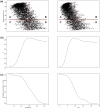Determining Clinically-Viable Biomarkers for Ischaemic Stroke Through a Mechanistic and Machine Learning Approach
- PMID: 35364704
- PMCID: PMC9079032
- DOI: 10.1007/s10439-022-02956-7
Determining Clinically-Viable Biomarkers for Ischaemic Stroke Through a Mechanistic and Machine Learning Approach
Abstract
Assessment of distal cerebral perfusion after ischaemic stroke is currently only possible through expensive and time-consuming imaging procedures which require the injection of a contrast medium. Alternative approaches that could indicate earlier the impact of blood flow occlusion on distal cerebral perfusion are currently lacking. The aim of this study was to identify novel biomarkers suitable for clinical implementation using less invasive diagnostic techniques such as Transcranial Doppler (TCD). We used 1D modelling to simulate pre- and post-stroke velocity and flow wave propagation in a typical arterial network, and Sobol's sensitivity analysis, supported by the use of Gaussian process emulators, to identify biomarkers linked to cerebral perfusion. We showed that values of pulsatility index of the right anterior cerebral artery > 1.6 are associated with poor perfusion and may require immediate intervention. Three additional biomarkers with similar behaviour, all related to pulsatility indices, were identified. These results suggest that flow pulsatility measured at specific locations could be used to effectively estimate distal cerebral perfusion rates, and ultimately improve clinical diagnosis and management of ischaemic stroke.
Keywords: Biomarker; Brain circulation; Cardiovascular modelling; Gaussian process emulator; Ischaemic stroke; Leptomeningeal collateral; Sensitivity analysis; Wave propagation.
© 2022. The Author(s).
Figures








References
-
- Bellner, J., B. Romner, P. Reinstrup, K. A. Kristiansson, E. Ryding, L. Brandt. Transcranial Doppler sonography pulsatility index (PI) reflects intracranial pressure (ICP). Surg Neurol 62(1):45–51 (2004) - PubMed
-
- Benemerito, I., A. P. Narata, A. Narracott, A. Marzo. 1D model of the human cerebral vasculature: Circle of Willis and leptomeningeal anastomoses. Figshare. 202210.15131/shef.data.19119509
-
- Bertaglia G, Navas-Montilla A, Valiani A, Monge Garcia MI, Murillo J, Caleffi V. Computational hemodynamics in arteries with the one-dimensional augmented fluid-structure interaction system: viscoelastic parameters estimation and comparison with in-vivo data. J. Biomech. 2020;100:109595. doi: 10.1016/j.jbiomech.2019.109595. - DOI - PubMed
MeSH terms
Substances
Grants and funding
LinkOut - more resources
Full Text Sources
Medical

